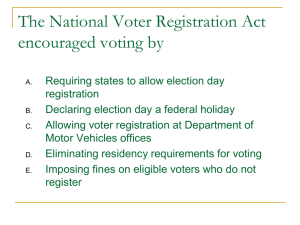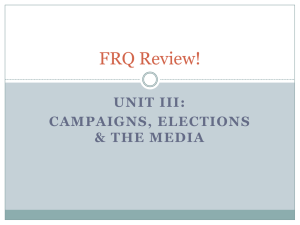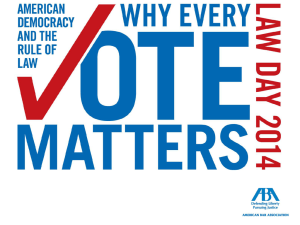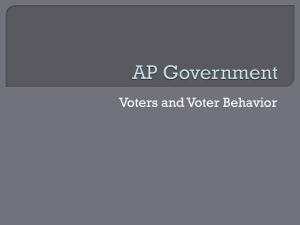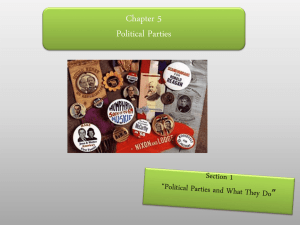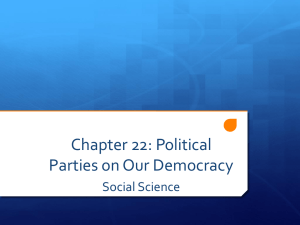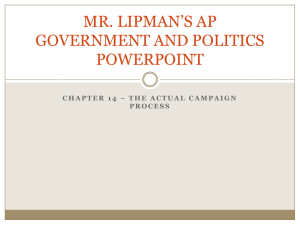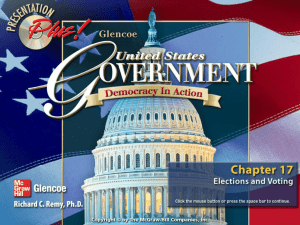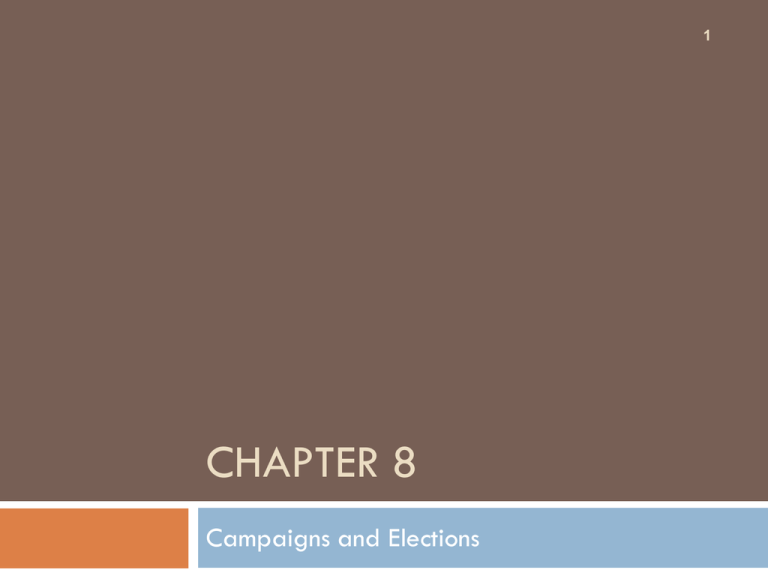
1
CHAPTER 8
Campaigns and Elections
Campaigns and Elections
2
Introduction: An election campaign is a complex
event involving many actors.
The Voters Perspective: To Vote or Not to Vote
Introduction
Interest
in politics increases around major elections.
Few Americans become involved in campaigns beyond
casual interest and discussion.
Voting is the most frequent meaningful act of political
participation.
Voter Eligibility
3
Historical restrictions:
Race
The Fifteenth Amendment granted voting rights to African
Americans.
Jim Crow laws – such as the literacy test, poll tax, grandfather
clause, and white primary – continued to deny African
Americans the right to vote in the South.
These barriers were eliminated by constitutional amendments,
Supreme Court decisions, and legislative acts.
Sex
Gender based restrictions on voting were eliminated by the
Nineteenth Amendment, which granted female suffrage.
The Twenty-sixth Amendment reduced the voting age from
21 to 18.
Voting Turnout by Family Income, 2008 and
Presidential Voting Choice by Income, 2008
4
Voter Eligibility
5
Today, voting restrictions can exclude noncitizens,
felons, mental patients, and those who don’t meet
residency requirements (now limited to 30 days).
Registration
Mail-in
and election day registration opportunities
increase voter turnout.
Democrats tend to favor making registration easier,
while Republicans typically oppose it.
Originally, registration was intended to prevent voter
fraud.
Who Votes?
6
Social Characteristics
There is now a general convergence in voting rates
among various types of citizens.
Older people, more educated people, and people with
higher incomes are all more likely to vote.
Psychological Influences
The greater a person’s interest in politics and sense of
political efficacy, the more likely that person will vote.
The stronger a person’s attachment to a political party,
the more likely that person will vote.
Offices and Elections
Turnout is high for high-stimulus elections and low for lowstimulus elections.
Declining Turnout
7
While voter turnout has varied since the late
nineteenth century, it is now at one of its lowest
low points.
Decline in turnout has been attributed to
registration and voting procedures, political
alienation, decreasing partisanship, and low
political efficacy.
Whether low voter turnout has a negative impact
on democracy has been a matter of debate.
Turnout in Presidential and
Congressional Elections, 1790-2010
8
Since the end of
the nineteenth
century, the longterm historical
trend has been
downward.
Turnout for
midterm
congressional
elections is lower
than in
presidential
elections.
The Voter’s Perspective: How to Vote
9
Parties
For
many years, affiliation with a political party was
the mainstay of decision making in voting.
Since the role of the party has weakened, this is no
longer as important a determinant in voting decisions.
This has left room for candidate characteristics and
issues to have an impact on decision making.
Candidates
Opinions
about candidates themselves play a powerful
role in influencing voters.
Voters emphasize political experience, effective
leadership, and attractive personal qualities.
The Voter’s Perspective: How to Vote
(continued)
10
Issues
Issues
now affect voting choice more than ever
before.
Economic issues, especially those related to personal
well-being, greatly affect voting choice.
Ideology also has some effect on voting choice.
Conclusion
Parties,
issues, and candidates are related in complex
ways as they all influence the vote during presidential
elections.
The Economy and Presidential Voting
11
The better the economy, the better the candidate of the incumbent party does in the presidential
election. The diagonal line shows the basic trend in the relationship—that is, how much, on average,
voting is related to improvements in the economy. In 2008, the economy was the number one issue
mentioned by voters in pre-election polls. Thus, it should not be surprising that the candidate
representing the incumbent party lost in a landslide.
The Candidate’s Perspective:
Running for President
12
Who runs for president?
Constitutional qualifications* include the following:
Natural-born
citizenship
A 14-year residency
Being at age 35
Limitation to two terms
*(According to the Twenty-second Amendment).
Other qualifications might include the following:
Experience
in a high political office (or being an incumbent)
Being on the successful side of mainstream America
Having a clean personal and political reputation
Having an attractive image
Most importantly—one’s determination
The Media Campaign
13
Candidates’ principal concern now is mobilizing
the media.
Free television time is gained through the use of
interviews and short “sound bites.”
Candidates have come to rely on professional
media consultants to plan campaign strategy.
The media focus has turned towards opinion
polls and the “horse race” aspects of a
campaign.
Percentage of Voting-Age Population that
Votes in Twenty-One Western Countries
14
The United
States ranks
near the bottom
of democratic
countries in the
percentage of
the voting-age
population that
actually votes,
primarily
because it places
more obstacles
in front of the
voter and offers
fewer incentives
to the voters.
Financing the Campaign
15
The Federal Election Campaign Act (FECA) requires
disclosure of funding sources and puts limits on
campaign contributions and candidate spending.
The Revenue Act of 1971 allows taxpayers to
contribute to Presidential Election Campaign Funds.
Major-party candidates can opt for federal financing if
they refuse public contributions after the convention.
The “soft-money” loophole provides a means to raise
unlimited amounts of money at the state and local level
that can indirectly be used for the presidential
campaign.
Getting Nominated
16
Party caucuses have recently gained in importance,
particularly the early Iowa caucus.
Primary elections are elections that select party
nominees for the general election.
Open primaries allow any voter to participate, regardless
of party affiliation.
Closed primaries restrict participation to just members of
a specific party.
The earliest presidential primaries are the most
important in sorting out potential candidates.
The party conventions select party nominees, draft rules,
and write the party platform.
Choosing a Running Mate
17
The vice-presidential nominee is usually chosen
to balance the ticket.
The choice of a running mate is made by the
presidential candidate.
The vice president is less an object of scorn
than in the past.
The vice-presidency is often the most direct
path to the presidency.
Getting Elected
18
The president is elected indirectly through the electoral
college, in which each state has electors equal to the
number of representatives and senators from that state,
thus setting the stage for an emphasis on large states in the
campaign.
Candidates seek to instill an image in the minds of the
voters, giving incumbents a distinct advantage.
Candidates must decide on whether to confront or evade
issues.
Debates are risky for an incumbent but can be the best
strategic opportunity for a non-incumbent.
Campaign strategy is at the mercy of events that can make
a candidate look either inept or “presidential.”
Proposals to Reform Electoral
Mechanics Include the Following:
19
Shifting to one national primary or a series of
regional primaries
Replacing the electoral college with a direct
popular election of the president or a
congressional district winner-take-all system
Changing the two-term limit placed on
presidents
The Candidate’s Perspective:
Running for Congress
20
Campaign Financing
House
and Senate elections have become very
expensive.
There is no public financing for congressional
campaigns.
There have been efforts to get around restrictions
imposed by federal campaign finance laws.
Money helps challengers more than office
holders.
The Candidate’s Perspective: Running
for Congress (continued)
21
Incumbency
Incumbency
is even more an asset to members of
Congress, especially in the House, than it is to
presidents.
Five out of six congressional districts are safe seats.
Incumbents
Are
better known
Can take credit for all beneficial activity the federal
government undertakes in their states and districts
Can raise money easier
Can use the resources of their offices, such as franking
privilege, to get reelected
The Candidate’s Perspective: Running
for Congress (continued)
22
Parties, Candidates, and Issues in Voting for Congress
After incumbency, the single most important determining
factor when it comes to voting in congressional elections is
party.
Except for those related to the economy, issues are of
little importance in congressional elections due to the lack
of information.
Candidates for the House are judged on the qualities of
trust and competence, while Senate candidates are
judged in terms of experience and ability.
Presidential Popularity
23
When congressional elections coincide with a
presidential election, a presidential candidate
who is popular can help his party’s congressional
candidates. This is referred to as “having
coattails.”
In midterm elections, the congressional vote may
also be interpreted as a referendum on how well
the president is doing.
The president’s party, historically, loses seats in
midterm elections.


